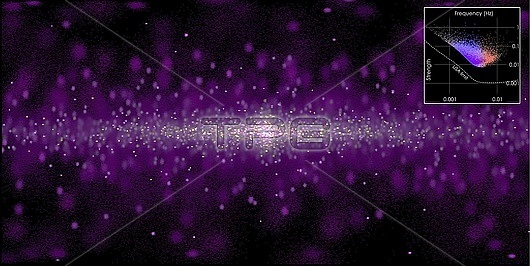
Gravitational wave simulation of the Milky Way. This is a view of the entire sky as it would appear in gravitational waves, cosmic ripples in space-time generated by orbiting objects. Our galaxy is filled with so-called ultracompact binaries (UCBs) expected to contain objects like white dwarfs, neutron stars and black holes in tight orbits. However, gravitational waves hum at frequencies too low for ground-based detectors to 'hear' them. Future gravitational wave detectors such as the European Space Agency's Laser Interferometer Space Antenna (LISA) in collaboration with NASA, will detect tens of thousands of these UCBs to study the Milky Way in gravitational waves just like astronomers study it in X-rays. The simulated image shows UCBs concentrated in the plane of the Milky Way's spiral disc and spilling out into the galactic halo. Brighter spots indicate sources with stronger signals and lighter colours indicate those with higher frequencies. The inset shows the frequency and strength of the gravitational signal, as well as the sensitivity limit for LISA. Maps like this using real data will be possible when space-based observatories such as LISA become available in the 2030s, and it will allow astronomers to observe the universe in a completely different way.
| px | px | dpi | = | cm | x | cm | = | MB |
Details
Creative#:
TOP29308780
Source:
達志影像
Authorization Type:
RM
Release Information:
須由TPG 完整授權
Model Release:
Not Available
Property Release:
Not Available
Right to Privacy:
No
Same folder images:

 Loading
Loading